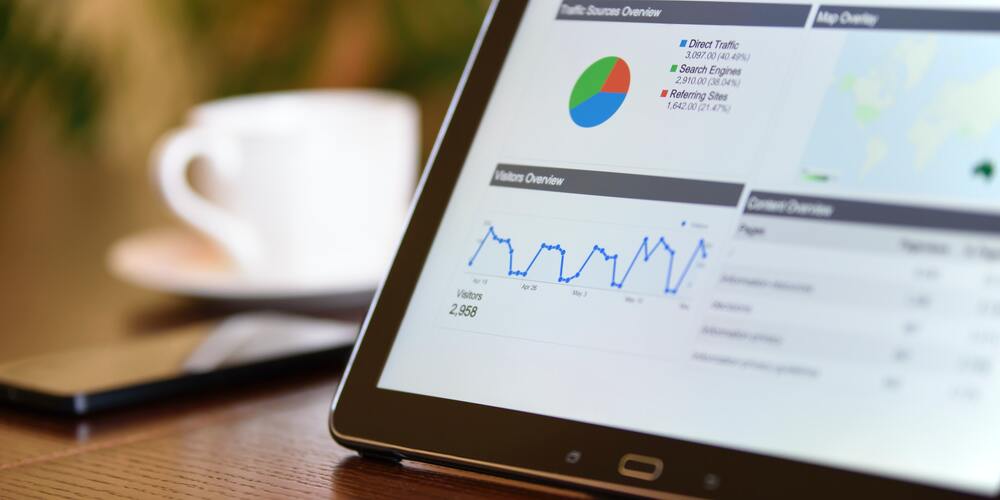Even if you don’t run in data-savvy circles, you’ve probably heard whispers of GA4 on the wind. Maybe it cropped up in a casual conversation around the water cooler or you saw it in a news article you were reading. At first, you didn’t pay any mind but now the term seems to be everywhere.
Google Analytics 4 (GA4) is the newest iteration of Google’s web analytics platform. The search engine giant has been slowly introducing this update, allowing users to upgrade at their own pace, but this year it will completely replace the current version, Universal Analytics (UA). The transition will officially start on July 1, 2023, when Universal Analytics properties are terminated and accounts will stop recording data. All new data will come through GA4.
If you’re thinking, “Wow that’s big,” then you’re right. There’s been a ton of buzz about this new and improved version, and if you’ve had the pleasure of already setting up your account, then you know GA4 is more than just minor tweaks and adjustments. It’s a whole new system, with new navigation, new functionality and a new approach to reporting data.
I chatted with Ali DeLeo, MarTech Team Lead, who will help us better understand the new features of GA4 and why it’s important to migrate before the deadline.
Major Changes
Google defines GA4 as “a new property for the future of measurement.” (Property is the term Google uses for its platform, which tracks data unique to your website.) But what does the “future of measurement” look like?
- Greater focus on the customer journey and accompanying data
- Event-based data instead of session-based
- Privacy controls such as cookieless measurement and behavioral and conversion modeling
- Custom reporting for specific audience segments
- Predictive metrics powered by AI
Customer Journey
GA4 is all about the customer journey. In fact, it was a large reason Google decided to overhaul its analytics platform. They wanted more ways for businesses to track their customers and how they engaged with the brand.
Ali notes that one of the biggest benefits of increased attention to the customer journey is that you can now track specific users from event to event across multiple devices. Businesses can now see the top screens users view and engage with, the path they took to get there, which events they triggered and even what type of engagement they made with the page.
“For example, imagine someone viewed your product photo on their phone, then they went to your app to read about it, then they made the purchase from their computer the next day,” Ali explains. “In GA4, you can see this whole journey and assess how people are interacting with both your website and app.”
Event-based Data
In its efforts to further support quantifying the customer journey, GA4 also uses event-based data. In UA, reports were session-based, meaning they measured user interactions over a set period of time. This was valuable if your sales cycle was relatively short or people tended to complete their journey quickly. However, businesses with longer cycles had more trouble getting the full picture of their users’ interactions with their sites.
“Instead of the old session-based data model that really only focused on sessions and pageviews, you now have a more holistic view of every user interaction on your site,” Ali explains. “This gives you a much clearer picture of not only how users are moving through your site but what they’re doing as they browse your site or app.”
With event-based reporting, you can now measure or view specific interactions that users took on your website or app. This might be loading a page, downloading a file, clicking on a link or any other custom event you set in your account. GA4 automatically collects certain events and offers custom events if you have something specific you need to measure.
The real cherry on top is that you don’t have to choose between the two. You can implement both recommended (automatically collected) and custom events to gather exactly the information you need to support your business.
Privacy Controls
A significant improvement in GA4 is the expanded privacy controls. This change was sparked by growing concerns about data privacy, as the EU cracks down on what user information can be collected and stored.
“The biggest improvement here is the default IP anonymization,” Ali says. “That means that Google Analytics no longer stores IP addresses of user devices. In previous versions, it was possible to activate this feature but people had to go in and do it themselves, which was a pretty difficult process.”
This switch to default IP anonymization marks a step toward becoming General Data Protection Regulation (GDPR) compliant. Ali notes that GA4 is not currently GDPR compliant, which means you may have to take some extra steps to ensure that your site is. A few recommended actions include:
- Adding a cookie banner on your website
- Ensuring site security by installing an SSL certificate
- Include privacy statements on any forms on your website
- Provide a data rights provision
Custom Reporting
Although it’s the last thing on this list, reporting is probably the first thing expert UA users noticed when they first signed into GA4. Google switched out its automatic and custom dashboards for more detailed reporting options. Now, instead of navigating to the content drill down or behavior tab, you can create custom reports that target a specific audience segment.
The cool thing about this is that you can get information that’s highly targeted to your business goals. Google explains: “Audiences let you segment your users in the ways that are important to your business. You can segment by dimensions, metrics, and events to include practically any subset of users.”
“There are so many reasons why this is a great tool for businesses,” Ali says excitedly. “Segmenting your audience based on metrics and events allows you to fully understand each persona. With these segments, you can show different ads to different users if you’re using Google Ads, or you can compare audience segments in GA4. That shows you how metrics differ with each segment and how each one performs over time.”
You can take full advantage of segmented audiences in the new “Explore” tab. From there, GA4 allows you to build custom reports either from scratch or a template so you can explore things like how people interact with a sales funnel, user flows and behavior, audience segment relationships and more.
Predictive Metrics
The last major change that Ali notes is GA4’s increased use of predictive analytics. It’s important to note that machine learning isn’t anything new to Analytics — that’s how Google runs its search engine and has always run Analytics, too — but Google has stepped up its game.
Unlike UA, GA4 has the power to highlight data trends. It can show you increasing demand for a product, anticipated churn rate, potential revenue, etc., all for a specific audience segment. The goal is to allow you insights to customer behaviors so you can focus on the most valuable audience segments.
Do I Have to Switch to GA4?
Yes. As of July 1, 2023, Google will sunset UA properties so they no longer gather data. On that day, all UA accounts will stop processing new hits and tracking new data from your website. You’ll still have access to your old data, but you won’t be able to do anything with your portal moving forward.
The last day to switch from UA to GA4 is July 1, 2024. This extended deadline is intended to give enterprise-level businesses more time to get set up in their new portals.
Because we all like to put off updates — especially one that will change our interface — Ali offers a few reasons you should migrate your data now rather than later.
“First is GDPR,” she notes. “If you need or want to be compliant, then you should look into migrating to GA4 so you aren’t scrambling trying to figure out those requirements a day before you lose UA.”
For those already established in UA, Ali advises making the switch early so you have time to get set up in GA4 and start collecting meaningful data. She recommends backing up your data and making note of all the integrated tools you use in your portal.
“Any integrated tools will be lost when you make the switch. So starting the move sooner will allow you to have time to make the change, start collecting data and set up all those tools you need.”
She adds that if you’re in the process of creating a new website and adding analytics, it makes more sense to set up in GA4 instead of using UA and having to migrate in a few months. It saves you from potentially losing data and the hassle of re-integrating all your external tools.
How to Migrate Your Data
If you’re starting from scratch with a new website, simply set up your Google Analytics account using GA4. The platform will walk you through the necessary steps to get started.
If you’re migrating an existing UA account, the process is a bit more hands on. Google lists these five basic steps to move your account to GA4:
- Create a GA4 property and data stream
- Collect website and app data (if applicable)
- Turn on Google signals (if applicable)
- Set up conversions
- Add Users
We Can Help
We know that everyone is tech confident enough to move all of their business data into a new account. That’s okay. We have a few Google Analytics enthusiasts who can help.
Our MarTech specialists can help you set up or migrate your Google Analytics account to GA4 and start tracking your data. Reach out to us to learn more about getting started.








